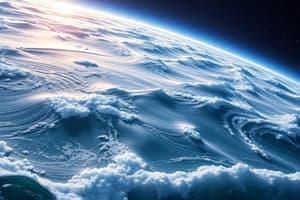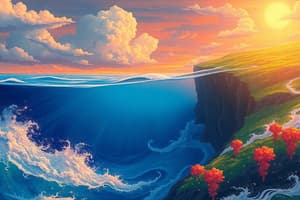Podcast
Questions and Answers
Which of the following best describes the primary cause of Earth's seasons?
Which of the following best describes the primary cause of Earth's seasons?
- The varying speeds at which Earth orbits the Sun during different times of the year.
- Variations in solar energy output throughout the year.
- The tilt of Earth's axis of rotation relative to its orbital plane. (correct)
- Changes in Earth's distance from the Sun due to its elliptical orbit.
Which of the following processes is an example of a positive feedback loop related to Earth's heat budget?
Which of the following processes is an example of a positive feedback loop related to Earth's heat budget?
- The increase in vegetation cover that absorbs more carbon dioxide.
- The melting of ice and snow, leading to decreased albedo and increased absorption of solar radiation. (correct)
- The formation of clouds that reflect incoming solar radiation.
- The evaporation of water, leading to increased humidity and cloud formation.
What are the two most abundant gases in Earth's atmosphere?
What are the two most abundant gases in Earth's atmosphere?
- Oxygen and Carbon Dioxide
- Nitrogen and Oxygen (correct)
- Argon and Carbon Dioxide
- Hydrogen and Helium
How does increasing air density typically affect air pressure?
How does increasing air density typically affect air pressure?
Which of the following is the primary difference between weather and climate?
Which of the following is the primary difference between weather and climate?
How does the Coriolis effect influence the direction of winds in the Northern Hemisphere?
How does the Coriolis effect influence the direction of winds in the Northern Hemisphere?
Which of the following statements best describes the typical wind patterns associated with high-pressure systems?
Which of the following statements best describes the typical wind patterns associated with high-pressure systems?
During the day, coastal areas often experience a sea breeze. What is the primary reason for this phenomenon?
During the day, coastal areas often experience a sea breeze. What is the primary reason for this phenomenon?
Which of the following is a typical consequence of El Niño?
Which of the following is a typical consequence of El Niño?
What is the thermocline?
What is the thermocline?
Which factor primarily drives surface ocean currents?
Which factor primarily drives surface ocean currents?
As a wave approaches the shore and begins to break, what happens to its wavelength and height?
As a wave approaches the shore and begins to break, what happens to its wavelength and height?
In deep-water waves, what is the relationship between wave speed, wavelength, and period?
In deep-water waves, what is the relationship between wave speed, wavelength, and period?
What is the primary generating force for most waves?
What is the primary generating force for most waves?
How do shallow water waves differ from deep water waves?
How do shallow water waves differ from deep water waves?
What is the main cause of tides on Earth?
What is the main cause of tides on Earth?
During which phase of the moon are spring tides most pronounced?
During which phase of the moon are spring tides most pronounced?
How do lunar tides differ from solar tides in terms of their influence on Earth's oceans?
How do lunar tides differ from solar tides in terms of their influence on Earth's oceans?
What is the typical pattern of a semidiurnal tide?
What is the typical pattern of a semidiurnal tide?
Why is the Moon's tide-generating force greater than the Sun's, despite the Sun's much larger mass?
Why is the Moon's tide-generating force greater than the Sun's, despite the Sun's much larger mass?
Flashcards
Latitude of Direct Sunlight
Latitude of Direct Sunlight
The latitude where the sun's rays hit the Earth most directly, varying throughout the year due to Earth's tilt.
Ice-Albedo Feedback Loop
Ice-Albedo Feedback Loop
A feedback loop where melting ice reduces Earth's reflectivity (albedo), leading to more solar energy absorption and further warming.
Forces of Heat Distribution
Forces of Heat Distribution
Solar radiation and gravity drive heat distribution. Wind transports heat from areas with more radiation to areas with less.
Gases in the Atmosphere
Gases in the Atmosphere
Signup and view all the flashcards
Factors Affecting Air Density
Factors Affecting Air Density
Signup and view all the flashcards
Coriolis Force
Coriolis Force
Signup and view all the flashcards
Prevailing Wind Patterns
Prevailing Wind Patterns
Signup and view all the flashcards
Wind Rotation
Wind Rotation
Signup and view all the flashcards
Heat Distribution on Earth
Heat Distribution on Earth
Signup and view all the flashcards
Direction of Winds
Direction of Winds
Signup and view all the flashcards
Major Wind Bands
Major Wind Bands
Signup and view all the flashcards
Monsoons
Monsoons
Signup and view all the flashcards
El Nino/La Nina
El Nino/La Nina
Signup and view all the flashcards
Thermocline and Halocline
Thermocline and Halocline
Signup and view all the flashcards
Surface Current Gyres
Surface Current Gyres
Signup and view all the flashcards
Wave Formation Process
Wave Formation Process
Signup and view all the flashcards
Wave Characteristics
Wave Characteristics
Signup and view all the flashcards
Breaking Wave
Breaking Wave
Signup and view all the flashcards
Tide Wave Parts
Tide Wave Parts
Signup and view all the flashcards
Lunar vs Solar Tides
Lunar vs Solar Tides
Signup and view all the flashcards
Study Notes
- Exam 2 reviews chapters 6, 7, 8, and 9
Chapter 6: Atmosphere and Oceans
- Solar radiation input varies with seasons; the sun's rays are most direct at specific latitudes depending on the season.
- The ice-albedo positive feedback loop relates to the Earth's heat budget.
- The primary forces governing heat distribution on Earth should be named.
- Atmospheric composition mainly consists of two gases, and their percentages should be known.
- Factors affecting air density are important to describe.
- Weather and climate should be compared and contrasted.
- The Coriolis force requires explanation.
- Earth's prevailing wind patterns are determined by high and low pressure areas, as well as the three cell types in each hemisphere
- Wind rotation around high and low pressure systems differs in the Northern and Southern hemispheres.
- Heat distribution on Earth's surface needs a description and explanation.
- Winds exist, and their direction is determined by specific factors
- Major wind bands need to be matched with their latitudes.
- The names and directions of the major wind bands on Earth should to be known.
- The ice/albedo feedback loop requires a description.
- Coastal wind patterns vary between day and night, which is related to monsoons in India
- Causes and consequences of El Nino/La Nina are significant phenomena
Chapter 7: Ocean Structure and Circulation
- Temperature and salinity plotted against depth help identify the thermocline and halocline.
- Seasonal thermocline changes at mid-latitudes throughout the should be sketched with mixed layer depths for each season.
- Four different water masses and their formation processes/locations should be listed and described.
- The formation of surface current gyres should be understood and explained.
- Major currents in each gyre should be known.
- Wind-driven currents within each gyre should be identified.
- Major water masses relative to each other with depth across the Atlantic Ocean should be sketched
- The Great Ocean Conveyor Belt should be sketched.
Chapter 8: Waves
- Wave formation involves generating and restoring forces.
- Basic wave characteristics include the wave crest, trough, height, and wavelength.
- Wavelength, wave period, wave frequency, and steepness are key wave definitions
- Wave breaking points can be determined
- Wave dispersion occurs with distance from a storm
- Wave size is affected by certain factors
- Shallow and deep water waves should be compared.
- Wave interactions are important
- A tsunami should be described.
Chapter 9: Tides
- Tides are waves with identifiable crests, troughs, wavelength, wave height, amplitude, and period.
- Lunar and solar tides should be compared.
- Wave velocity varies at each phase of the tide.
- Diurnal, semidiurnal, and mixed semidiurnal tides should be compared.
- Basic characteristics of the three tidal patterns should be labeled.
- High tide times can be calculated for diurnal and semidiurnal tides given the last high tide.
- The Moon's tide-generating force is greater than the Sun's despite the Sun's mass and gravitational attraction
- The Earth-Moon-Sun system alignment can be diagrammed during spring and neap tides
- Solar and lunar tides interact during spring and neap tides.
Studying That Suits You
Use AI to generate personalized quizzes and flashcards to suit your learning preferences.




